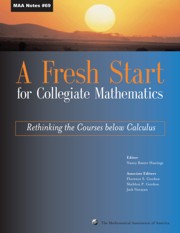Book contents
- Frontmatter
- Preface
- Contents
- Introduction
- Background
- Theme 1 New Visions for Introductory Collegiate Mathematics
- 7 Refocusing Precalculus: Challenges and Questions
- 8 Preparing Students for Calculus in the Twenty-First Century
- 9 Preparing for Calculus and Preparing for Life
- 10 College Algebra: A Course in Crisis
- 11 Changes in College Algebra
- 12 One Approach to Quantitative Literacy: Understanding our Quantitative World
- Theme 2 The Transition from High School to College
- Theme 3 The Needs of Other Disciplines
- Theme 4 Student Learning and Research
- Theme 5 Implementation
- Theme 6 Influencing the Mathematics Community
- Ideas and Projects that Work: Part 1
- Ideas and Projects that Work: Part 2
11 - Changes in College Algebra
from Theme 1 - New Visions for Introductory Collegiate Mathematics
- Frontmatter
- Preface
- Contents
- Introduction
- Background
- Theme 1 New Visions for Introductory Collegiate Mathematics
- 7 Refocusing Precalculus: Challenges and Questions
- 8 Preparing Students for Calculus in the Twenty-First Century
- 9 Preparing for Calculus and Preparing for Life
- 10 College Algebra: A Course in Crisis
- 11 Changes in College Algebra
- 12 One Approach to Quantitative Literacy: Understanding our Quantitative World
- Theme 2 The Transition from High School to College
- Theme 3 The Needs of Other Disciplines
- Theme 4 Student Learning and Research
- Theme 5 Implementation
- Theme 6 Influencing the Mathematics Community
- Ideas and Projects that Work: Part 1
- Ideas and Projects that Work: Part 2
Summary
Introduction
The high rate of students' failure in the college algebra course could be a problem originating in admissions policies, placement activities, curriculum design, or instruction. This paper focuses on the curriculum as a partial solution to this problem, in light of the needs of the types of students who tend to enroll in the course.
The traditional college algebra curriculum seems to assume that the course is a preparation for calculus. However, surveys at many institutions have shown that only a minority of college algebra students go on to take calculus of any kind, and only a small fraction of those attempt a full-year calculus sequence. In the mid-1990's, the National Science Foundation sponsored a colloquium to examine the nature and purpose of the college algebra course [17,18], and in recent years, some textbook authors have developed alternative curricula that address the future mathematical needs of the soft-sciences students. This paper contrasts these new curricula with the traditional college algebra course and identifies the related issues of national and local educational policy.
The DWF problem
The 1997 MAA panel discussion on college algebra reform had one participant who was certainly an unusual guest at such meetings. He was a university president, and not himself a mathematician. Raymond Hicks, of Grambling State University, told the audience of his administration's concern about the high failure rate of college algebra students. It is not only bad public relations for the math department, he reminded the attendees, but it is demoralizing to the students.
- Type
- Chapter
- Information
- A Fresh Start for Collegiate MathematicsRethinking the Courses below Calculus, pp. 90 - 100Publisher: Mathematical Association of AmericaPrint publication year: 2006
- 3
- Cited by



